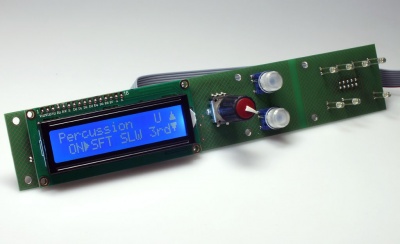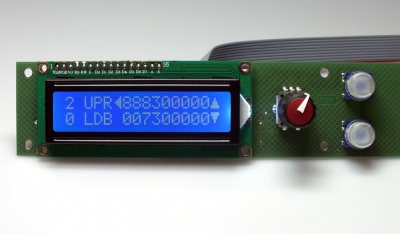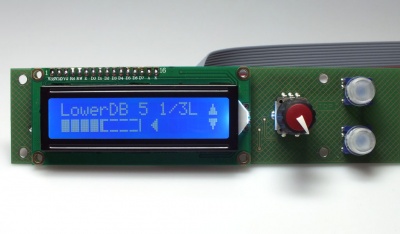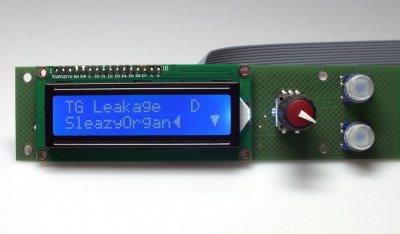HX3 MenuPanel
Last change: New Menu entries added for firmware 3.5 and stereo leslie simulation.
Installation
Just connect the MenuPanel to HX3 PL4 using a 10-wire flat ribbon cable. Only connect/disconnect when power is off. HX3 firmware from version 3.41 and up will recognize the MenuPanel and act accordingly. Remove protective film from LCD prior to final installation.
MenuPanel may be used in parallel/simultaneously with Preset12, Preset16 and Preset24 boards connected to HX3 PL4. Extend a flat ribbon with additional connector to your cable on HX3 PL4 or use unoccupied 10-pin header on (last) Preset16 board which also carries the PL4 signal. Display contrast ist factory set, but may be adjusted by small black trimpot behind LCD. Six pcs. of 12 mm plastic spacers or M3 (metric) bolts will be needed for front bezel installation.
Right PCB area may be fitted with seven standard 3 mm LEDs (plus/andode/longer wire points to bottom, square pads). Dependant on production date, you may have to solder 7 SMD resistors 220R size 0805 on back. Use higher values (470R to 1k5) if LEDs are too bright (especially on blue and white LEDs). Install optional 10-pin header from back and connect to HX3 PL7 to indicate percussion and vibrato ON/OFF setting. If HX3 PL7 is occupied by other user controls, wire in parallel (simply add plug to 10-wire flat ribbon cable).
Please find mechanical drawings, schematics and front panel layout for Schaeffer AG Frontplattendesigner software in our Github repository PLATINEN/MenuPanel directory (click "view raw" link to display/download .PDF and .FPD files). Frontplattendesigner software also allows DXF export for your own production.
Using the Menu System
Note:HX3 expander may be remoted via given MIDI CC set, but some settings are available via menu system only. Some parameters only applicable to HX3 equipped organ. If valid MIDI CC command received (despite expression/volume changes) for current MIDI CC configuration or tab/button switches on organ installation change state, MenuPanel will briefly show the changed parameter.
- Use the incremental encoder knob "DATA ENTRY" to change parameters or presets in main UPR/LWR menu.
- Press incremental encoder knob to go back to last menu intem used (Leslie Amp Volume by power-on default).
- Use Up/Down buttons to scroll through menu items. Press and hold for fast auto-repeat to next pramater group.
- Press incremental encoder button for 2 seconds or more to save a changed parameter (also by MIDI CC) or preset permanently (non-volatile). A message will appear briefly. Firmware 3.5 and up only: On changed default parameters which are not saved, an "*" asterisk will appear on upper line.
The menu system consists of about 70 entries. Drawbar, percussion and vibrato entries are only available on Expander firmware or with parameter "Expander mode" enabled. Pressing and holding the Up/Down buttons will enable fast auto-repeat which will stop briefly on menu group borders. A "<" arrow will direct to the parameter to be changed. Vertical arrows indicate if parameter is at limits.
If fitted with 7 indicator LEDs (default on HX3 expander), LEDs will show current percussion and vibrato state as well as Leslie speed (LED blinks according to rotary frequency).
Menus Upper
These parameters are saved to upper manual preset when encoder knob is pressed for more than 2 seconds. On "live" drawbar preset 0 (UDB) any changes are alwas saved temporarily and restored when returning from preset UPR to "live" UDB in main menu (or by preset keys on organ insatllation).
- UpperDB 1 to UpperDB 16 - drawbar setting for upper manual
- UPR<LWR Vibr - vibrato/chorus ON/OFF for upper manual
- UPR LWR Vibr< - vibrato knob setting V1 to C3
- Percussion - will step through available percussion combinations of NORM/SOFT, FAST/SLOW, 2nd/3rd (8 options) plus OFF.
Main Display Upper/Lower
- UPR XXXXXXXXX - default main menu, shows upper drawbars as numbers from 0 to 8 (here represented as "X"). Incremental knob changes UPR (upper preset) number. 0 is "live" setting UDB (upper drawbars). Returning from any preset UPR to drawbars UDB restores last drawbar setting, formerly set either by connected drawbars or received by MIDI CC (HX3 expander). This is also true for preset keys on organ installations.
- LWR XXXXXXXXX - same for pedal and lower drawbars, incremental knob changes preset number lower. Note: On firmware version 3.45 and up, lower line also contains two pedal drawbars: PXXLXXXXXXXXX.
Menus Lower
These parameters are saved to lower manual preset when encoder knob is pressed more than 2 seconds. On "live" drawbar preset 0 (LDB) any changes are alwas saved temporarily and restored when returning from preset LPR to "live" LDB in main menu (or by preset keys on organ insatllation).
- UPR LWR<Vibr - vibrato/chorus ON/OFF for lower manual
- LowerDB 16 to LowerDB 1 - drawbar setting for upper manual
- PedalDB 16 to PedalDB 8 - drawbar setting for pedals
- PedalSustain - changes pedal sustain release time. Set to 0 to obtain B3 pedal sound. Saved to lower preset
- BassOnLeslie - routes pedal signal to Leslie simulation if ON. Note: Not present on firmware 3.49 and below.
- Audio Jacks - Switches between two output configurations A or B which may be configured separately in Defaults section (see below). Only on firmware 3.5 and up; factory default A is stereo Leslie simulation on both plug tips and Organ/Pedal on plug rings, config B is tip/ring swapped.
- KeyboardSplit - set split ON or OFF, default pedal to lower, 2 octaves. If one key pressed while switching to ON on lower manual, this key will be the "pedal to lower" split point. If one key pressed while switching to ON on upper manual, this key will be the "lower to upper" split point, lower manual switched off. If two adjacent keys pressed while switching to ON on upper manual, this key will be the "pedal to upper" split point. Note: split point setting is only valid until power-off.
Menus Defaults
These parameters are saved to power-on defaults when encoder knob is pressed more than 2 seconds. Factory defaults are shown in brackets like <123>.
Commons Group
- LeslieVolume <70> - adjusts Leslie Amp simulation volume from 0 to full (overdriven tube amp).
- ReverbLevel <0> - adjusts reverb level OFF, 1, 2 or 3. Firmware 3.5 and up: Sets one of three different reverb programs, each adjustale (see below).
- MIDI Channel <1> - sets MIDI base receive channel 1 to 10 (upper manual, lower manual is on +1, pedals on +2).
- MIDI Option <RcvSendMerge> - sets MIDI routing behaviour to
- 'ReceiveThru' (MIDI OUT is THRU),
- 'ReceiveSend' (MIDI received, only own MIDI key events to MIDI OUT),
- 'RcvSendMerge'(MIDI received, own MIDI key events and incoming MIDI events merged to MIDI OUT) and
- 'RcvSndMgNoCC' (as before, but MIDI CC commands discarded). On expander module, only valid setting is 'ReceiveThru'.
- MIDI CC Set <NI B4> - sets recognized MIDI CC set to
- 'NI B4' Native Instruments B4 (default),
- 'Voce' MIDI drawbars,
- 'Hamichord' (or 'KeyB Duo' on special request),
- 'Hammond XK',
- 'Hammond SK' (Note: Hammond changed MIDI CC set between XK and SK series, so try out which will fit), or
- 'KeyB Duo'.
- SplitOption <PedalToLower> - split setting on power-up, engaged when split set to ON (see above)
- 'PedalToLower',
- 'LowerToUpper' or
- 'PedalToUpper'
- Transpose <0> - transposes from -6 to +7 semitones. Notes beyond 5 octave limits of B3 will not produce any sound due to accuracy of physical model.
- AudioJ Conf A <RotaryStereo> - sets audio jack configuration A and
- AudioJ Conf B <Organ/Pedal> - sets audio jack configuration B. There are 32 entries total on each configuration: 16 with no bass pedal added and 16 with bass pedal added to organ, amp and Leslie sim signals (marked by +B in display).
Menu entries differ from HX3 mk2 to mk3 boards. As the new HX3 mk3 board has only mono output jacks, only 2 signals are available at one time:
- Jack1 / Jack2
- Organ / BPed
- BPed / Organ
- Rotary L / R
- Rotary R / L
- Organ / RotL
- RotL / Organ
- BPed / RotR
- RotR / BPed
- Amp / BPed
- BPed / Amp
- Rotary L / R
- Rotary R / L
- Amp / RotR
- RotL / Amp
- BPed / RotR
- RotR / BPed
Description: Rotary L and R = rotary cabinet sim left/right channel, Organ = plain organ signal like G-G on B3, Amp = organ signal with tube amp simulation and overdrive (controlled by Leslie amp volume pot or parameter), BPed = Bass pedals.
The older HX3 mk2 has stereo output jacks, so all 4 possible signals are available simultaneously:
- Jack1 tip/ring - Jack2 tip/ring
- ORG/PD L/R
- PD/ORG R/L
- L/R ORG/PD
- R/L PD/ORG
- ORG/L PD/R
- L/ORG R/PD
- PD/R ORG/L
- R/PD L/ORG
- AMP/PD L/R
- PD/AMP R/L
- L/R AMP/PD
- R/L PD/AMP
- AMP/L PD/R
- L/AMP R/PD
- PD/R AMP/L
- R/PD L/AMP
Description: L and R = rotary cabinet sim left/right channel, ORG = plain organ signal like G-G on B3, AMP = organ signal with Leslie tube amp sim and overdrive (controlled by Leslie volume pot or parameter), PD = bass pedals.
Vibrato Group
- Vib1 AmplMod <28> - adjusts amplitude modulation caused by delay line on V1/C1 knob setting. Firmware 3.5 and up: replaced by vibrato linebox Age with more accurate modelling.
- Vib1 FreqMod <70> - adjusts frequency modulation on V1/C1 knob setting.
- Vib2 AmplMod <55> - adjusts amplitude modulation caused by delay line on V2/C2 knob setting. Firmware 3.5 and up: replaced by vibrato linebox Age with more accurate modelling.
- Vib2 FreqMod <110> - adjusts frequency modulation on V2/C2 knob setting.
- Vib3 AmplMod <80> - adjusts amplitude modulation caused by delay line on V3/C3 knob setting. Firmware 3.5 and up: replaced by vibrato linebox Age with more accurate modelling.
- Vib3 FreqMod <170> - adjusts frequency modulation on V3/C3 knob setting.
- ChorDryMix <160> - adjusts vibrato chorus mix dry (unmodulated) part in C1/C2/C3 setting.
- ChorVibMix <150> - adjusts vibrato chorus mix wet (FM/AM modulated) part in C1/C2/C3 setting.
- PercNormLvl <160> - adjusts percussion level in PERC ON, NORMAL tab setting.
- PercSoftLvl <85> - adjusts percussion level in PERC ON, SOFT tab setting.
- PercLongTm <14> - adjusts percussion decay rate in PERC ON, SLOW tab setting (higher value = faster).
- PercShortTm <30> - adjusts percussion decay rate in PERC ON, FAST tab setting (higher value = faster).
Generator Group
- TG Flutter <7> - adjusts tone generator "sloppyness" (spring clutch tension, bearing precision).
- TG Leakage <Old Organ> - sets tone generator leakage to
- 'OFF' (never seen that)
- 'New Organ' (recapped/new generator),
- 'Old Organ' (higher leakage on several notes) or
- 'Sleazy Organ' (lots of beer inside).
- TG OldCaps <OFF> - sets tone generator red caps (OFF) or wax caps (ON). With wax caps, TG notes also get more k2 distortion.
- No DB1 @Perc <ON> - enables drawbar 1 cancel when percussion ON (as original B3)
- No DB16 Foldb <OFF> - disables foldback on 16' lowest octave ("all way down" when ON). Note: on firmware 3.5 and up, Foldback is configurable in 4 settings:
- foldback with full level,
- foldback with muted level (original B3 behaviour),
- no foldback ("all way down") with full level (like H-100) or
- no foldback ("all way down") withmuted level.
- TrebleEqu <30> - mimics TONE pot on AO28 amp; well, a little bit more on high values.
- BassEqu <90> - bass equalizer, adjusts bass response of different AO28 models.
- AO28 tube k2 <12> - controls simulated AO28 preamp tube aging (higher triode distortion k2). Firmware 3.5 and up only.
- ContSpringFlx <6> - adjusts key contact spring flex, affects click length
- ContSpringDmp <9> - adjusts key contact spring damping, affects click frequency
Reverb Group
- Reverb 1 Lvl <100> - controls reverb amount and length on Reverb program 1 setting. Firmware 3.5 and up only.
- Reverb 2 Lvl <160> - controls reverb amount and length on Reverb program 2 setting. Firmware 3.5 and up only.
- Reverb 3 Lvl <170> - controls reverb amount and length on Reverb program 3 setting. Firmware 3.5 and up only.
Rotary Group
- HornSlowTm <16> - Leslie simulation horn revolution timer when set to SLOW
- RotorSlowTm <14> - Leslie simulation rotor revolution timer when set to SLOW
- HornFastTm <130> - Leslie simulation horn revolution timer when set to FAST
- RotorFastTm <120> - Leslie simulation rotor revolution timer when set to FAST
- HornRampUp <4> - Leslie simulation horn accelleration from SLOW to FAST. Firmware 3.5 and up only.
- RotorRampUp <20> - Leslie simulation rotor accelleration from SLOW to FAST. Firmware 3.5 and up only.
- HornRampDown <3> - Leslie simulation horn brake time from FAST to SLOW. Firmware 3.5 and up only.
- RotorRampDown <30> - Leslie simulation rotor brake time from FAST to SLOW. Firmware 3.5 and up only.
- Rotary Throb <200> - Leslie simulation "throb" modulation factor. Firmware 3.5 and up only.
- Rotary Spread <200> - Leslie simulation stereo spread (width). Firmware 3.5 and up only.
- Rotary Balnce <200> - Leslie simulation volume balance horn/rotor. Firmware 3.5 and up only.
Various Group
- ScanBoard <any> - sets scan core for attached scan board (MIDI only on expander)
- ExpanderMode <OFF> - disables all analog control pot/drawbar inputs despite swell pedal (ON default on expander)
- SwellInEna <ON> - enables swell pedal input jack, default ON
- FixedSwell <200> - fixed swell volume, only applies if swell pedal input jack (SwellInEna) is OFF
- TonePotEna <OFF> - enables analog control input for TONE pot (OFF on expander)
- LesVolPotEna <ON> - enables analog control input for 122 Amp simulation volume pot (OFF on expander)



